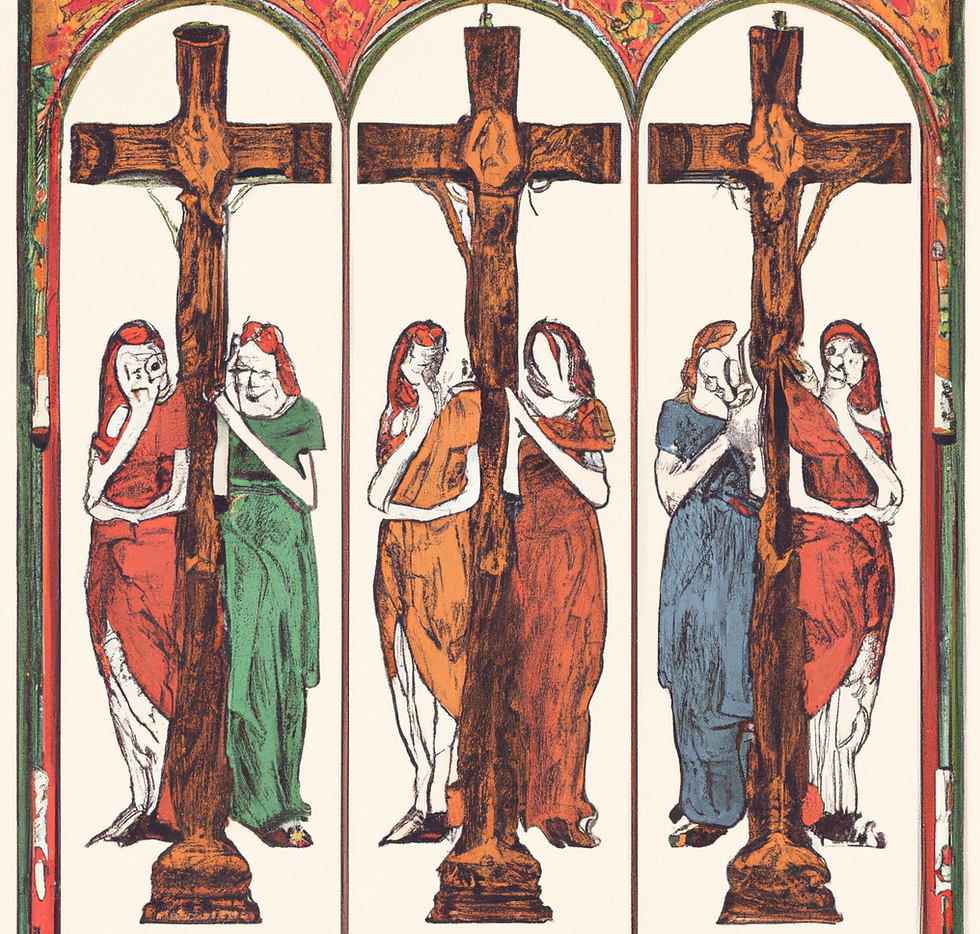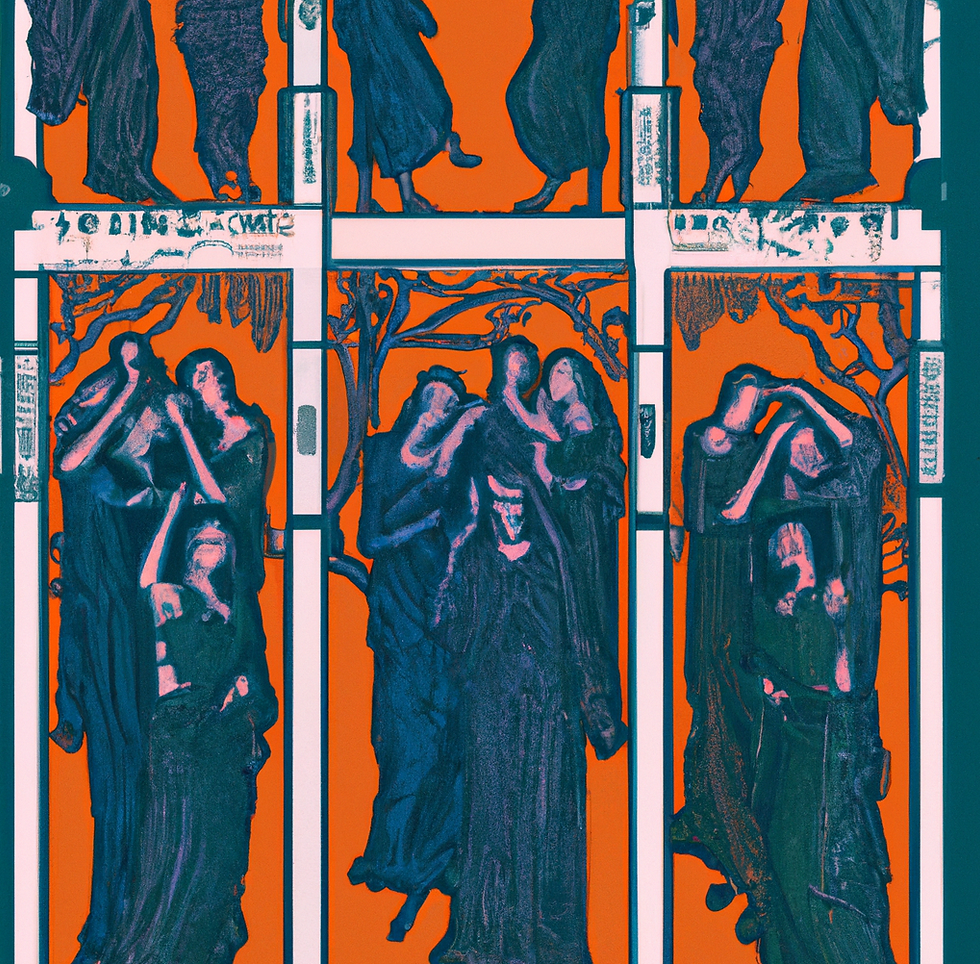The Sacred Journey: Praying the Rosary with the Stations of the Cross
- Fiach OBroin-Molloy

- Apr 17, 2024
- 3 min read
In the Christian tradition, the Stations of the Cross serve as a powerful devotional practice, guiding believers through the final hours of Jesus Christ's life. Similarly, the rosary is a cherished prayer tool that invites individuals to meditate on the life, death, and resurrection of Jesus. Combining these two sacred practices, praying the rosary structured around the Stations of the Cross offers a profound journey of reflection, contemplation, and spiritual renewal. In this blog post, we will explore the rich tradition of praying the rosary with the Stations of the Cross, examining its significance, structure, and transformative power.

Understanding the Stations of the Cross: The Stations of the Cross, also known as the Way of the Cross or Via Crucis, originated from the ancient Christian tradition of retracing Jesus' final steps on the road to Calvary. Consisting of fourteen stations, this devotional journey begins with Jesus' condemnation and ends with his burial. Each station represents a specific event or moment in Jesus' Passion, inviting believers to walk alongside him in his suffering and sacrifice (Pope John Paul II, 1991).
Exploring the Rosary: The rosary, a cherished prayer in Catholic tradition, is structured around repetitive prayers and meditations on the mysteries of the faith. Comprised of five decades of beads, each representing a set of prayers known as the Hail Mary, the rosary offers a structured framework for contemplative prayer. At the center of the rosary lies the crucifix, symbolizing the sacrifice of Jesus on the cross, while additional beads lead to the centerpiece, often depicting the Virgin Mary or another sacred image (Catechism of the Catholic Church, 971).
The Rosary of the Seven Sorrows: The Rosary of the Seven Sorrows, also known as the Servite Rosary, is a variant of the traditional rosary that focuses specifically on the sorrows of Mary during Jesus' Passion. Structured around seven mysteries, or sorrows, this rosary invites believers to accompany Mary in her grief and share in her profound love for her son. By meditating on Mary's sorrows, individuals deepen their understanding of Christ's suffering and the depth of Mary's compassion (Feingold, 2005).
Praying the Rosary with the Stations of the Cross: Praying the rosary structured around the Stations of the Cross combines the devotional practices of the rosary and the Stations, creating a seamless journey of prayer and meditation. In this format, each decade of the rosary corresponds to one of the fourteen Stations of the Cross, allowing believers to reflect on Jesus' Passion while reciting the prayers of the rosary. As they move from station to station, individuals immerse themselves in the profound mystery of Christ's redemptive love (Rausch, 2015).
The Power of Meditation and Contemplation: Praying the rosary with the Stations of the Cross offers a unique opportunity for meditation and contemplation. With each bead and each station, believers enter into the heart of Jesus' suffering, uniting their own struggles, sorrows, and joys with his. Through this prayerful journey, individuals deepen their relationship with Christ, finding solace, strength, and hope in his sacrifice and resurrection (Hauke, 2019).
Embracing Spiritual Transformation: Ultimately, praying the rosary with the Stations of the Cross is a transformative experience that invites believers to journey with Jesus through the depths of human suffering to the heights of divine glory. As individuals engage in this sacred practice, they are invited to surrender their burdens, fears, and doubts at the foot of the cross, trusting in God's mercy and love. In this act of surrender, they discover the power of redemption, healing, and renewal that flows from Christ's sacrifice (Garrigou-Lagrange, 2010).

Praying the rosary structured around the Stations of the Cross is a profound spiritual practice that invites believers to journey with Jesus through his Passion, death, and resurrection. By combining the rich traditions of the rosary and the Stations, individuals immerse themselves in the mystery of Christ's love and sacrifice, finding comfort, strength, and hope along the way. As they meditate on each station and recite the prayers of the rosary, they are drawn closer to the heart of Jesus, experiencing spiritual transformation and renewal. In this sacred journey, believers discover the power of prayer to illuminate the path of faith and lead them ever closer to God.

References:
Pope John Paul II. (1991). "Stations of the Cross at the Colosseum." Vatican News. https://www.vatican.va/content/john-paul-ii/en/homilies/1991/documents/hf_jp-ii_hom_19910403_via-crucis.html
Catechism of the Catholic Church. (1994). Vatican City: Libreria Editrice Vaticana.
Feingold, L. (2005). "The Rosary of Our Lady of Sorrows: Historical Overview and Meditation." Miles Jesu.
Rausch, T. P. (2015). "Mystical Prayer in the Rosary and the Way of the Cross." Theological Studies, 76(4), 767-794.
Hauke, M. (2019). "Rosary and Meditation: Theological and Pastoral Considerations." Angelicum, 96(3), 541-556.
Garrigou-Lagrange, R. (2010). "The Three Ages of the Interior Life: Prelude of Eternal Life." Tan Books.








Comments